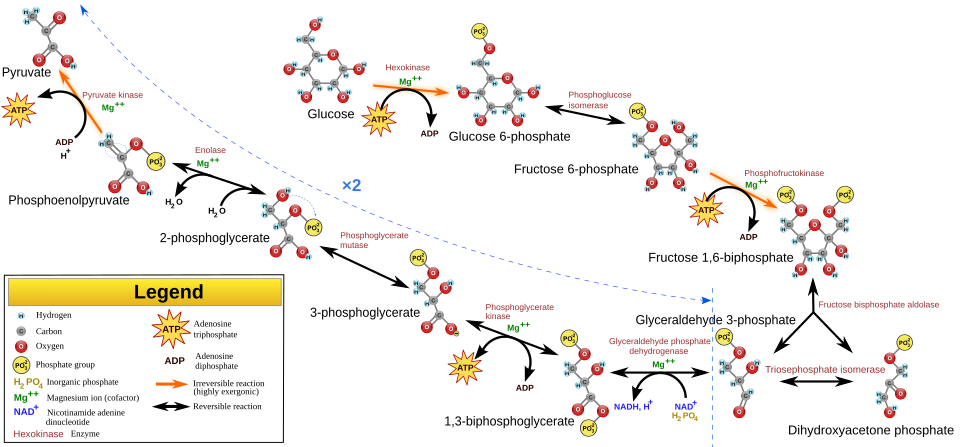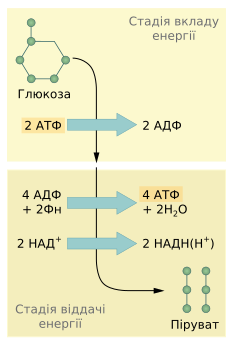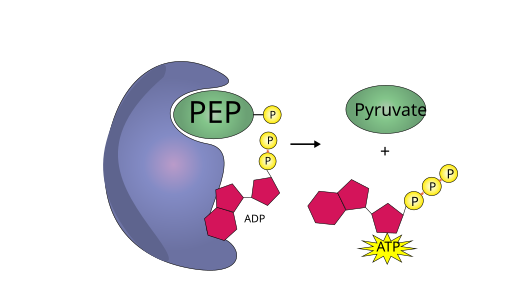OCR Specification focus:
‘Outline phosphorylation of glucose to hexose bisphosphate, splitting to two triose phosphates, oxidation to pyruvate, and small yields of ATP and reduced NAD.’
Glycolysis is the universal first stage of respiration, occurring in the cytoplasm of all living cells. It breaks down one glucose molecule into two pyruvate molecules, generating a small but vital yield of ATP and reduced NAD (NADH) without requiring oxygen.
The Role of Glycolysis in Cellular Respiration
Glycolysis is the initial stage of both aerobic and anaerobic respiration. It prepares glucose for further oxidation in the mitochondria (via the link reaction and Krebs cycle) if oxygen is available, or for conversion to lactate or ethanol if oxygen is absent.
This process is enzyme-controlled and does not require mitochondria, allowing it to occur in all organisms, from bacteria to humans.
Overview of Glycolysis
The process of glycolysis can be summarised as the conversion of glucose (6C) to two molecules of pyruvate (3C). It involves three main stages:

Comprehensive overview of the ten enzyme-controlled steps of glycolysis from glucose to two pyruvate. ATP investment and payoff steps, as well as NAD⁺ reduction, are clearly indicated. Extra enzyme names are shown but remain within the level ordinarily expected for A-level context. Source.
Phosphorylation – the activation of glucose by addition of phosphate groups.
Splitting (lysis) – the division of hexose bisphosphate into two triose phosphates.
Oxidation and ATP formation – conversion of triose phosphates to pyruvate with generation of ATP and reduced NAD.
Stage 1: Phosphorylation of Glucose
Phosphorylation is the first stage of glycolysis and involves the addition of phosphate groups to glucose. This step activates the molecule, making it more reactive.
One molecule of glucose (6C) is phosphorylated using two molecules of ATP.
The phosphate groups are transferred from ATP to glucose, forming hexose bisphosphate.
Energy investment occurs here—two ATP molecules are consumed to initiate the process.
Phosphorylation: The addition of a phosphate group to an organic molecule, often using ATP as the phosphate donor.
This stage ensures glucose is trapped inside the cell (phosphorylated glucose cannot diffuse out through the plasma membrane) and primed for breakdown.
Stage 2: Splitting of Hexose Bisphosphate
The hexose bisphosphate (6C) molecule is split into two triose phosphate (3C) molecules.
This process is catalysed by specific enzymes in the cytoplasm.
Each triose phosphate molecule will follow the same subsequent pathway.
No ATP is produced or consumed during this step.
Triose phosphate (TP): A three-carbon sugar phosphate that acts as an intermediate in both photosynthesis and respiration.
This marks the transition from the energy-investment to the energy-harvesting phase of glycolysis.

Simplified depiction of glycolysis phases, showing early ATP consumption and later ATP and NADH generation. The figure helps students connect stage names to the direction of energy flow. It omits full enzyme lists to keep focus on phase logic. Source.
Stage 3: Oxidation and ATP Formation
Each triose phosphate molecule undergoes oxidation, forming pyruvate while reducing NAD to NADH and producing ATP through substrate-level phosphorylation.

Diagram of substrate-level phosphorylation, where a high-energy intermediate donates phosphate directly to ADP → ATP. This mechanism operates in glycolysis at the phosphoglycerate kinase and pyruvate kinase steps. The figure is generic (not tied to a specific glycolytic intermediate), which keeps the concept clear without extra pathway detail. Source.
Each triose phosphate is oxidised by the removal of hydrogen atoms.
The hydrogen is accepted by NAD, forming reduced NAD (NADH).
The energy released from this oxidation drives the formation of ATP.
The final product of glycolysis is two molecules of pyruvate (3C).
Oxidation: The removal of hydrogen atoms or electrons from a molecule; often coupled with the reduction of another molecule such as NAD.
Each triose phosphate yields:
One molecule of NADH (from NAD).
Two molecules of ATP (via substrate-level phosphorylation).
Since two triose phosphates are produced from each glucose molecule, glycolysis yields:
Two pyruvate molecules
Two net ATP (four formed, two used in phosphorylation)
Two NADH molecules
EQUATION
—-----------------------------------------------------------------
Overall Glycolysis Reaction:
Glucose + 2 NAD⁺ + 2 ADP + 2 Pᵢ → 2 Pyruvate + 2 NADH + 2 ATP + 2 H₂O + 2 H⁺
NAD⁺ = Nicotinamide adenine dinucleotide (oxidised form)
NADH = Reduced form of NAD, carrying high-energy electrons and protons
ATP = Adenosine triphosphate, main energy currency of the cell
Pyruvate = Three-carbon compound, end-product of glycolysis
—-----------------------------------------------------------------
This stage generates energy directly usable by the cell and provides reduced coenzymes for later oxidative phosphorylation.
The Role of NAD in Glycolysis
NAD acts as an essential coenzyme in glycolysis.
It accepts hydrogen atoms (two protons and two electrons) during oxidation of triose phosphate.
This forms reduced NAD (NADH), which later donates electrons to the electron transport chain in the mitochondria during aerobic respiration.
Coenzyme: A non-protein organic molecule that temporarily binds to an enzyme to help it catalyse a reaction.
Without NAD, glycolysis would quickly stop because triose phosphate could not be oxidised to pyruvate.
ATP Yield from Glycolysis
Glycolysis produces a net gain of two ATP molecules per glucose molecule:
Four ATP molecules are formed during substrate-level phosphorylation.
Two ATP molecules are used during the phosphorylation of glucose.
Substrate-level phosphorylation: The direct synthesis of ATP by transferring a phosphate group from a phosphorylated intermediate to ADP.
This ATP is small compared to later stages of respiration but is vital in cells lacking oxygen or mitochondria, such as red blood cells.
The Fate of Pyruvate
The fate of pyruvate depends on oxygen availability:
Aerobic conditions: Pyruvate enters mitochondria and is oxidised in the link reaction, forming acetyl CoA for entry into the Krebs cycle.
Anaerobic conditions: Pyruvate acts as a hydrogen acceptor, regenerating NAD so glycolysis can continue, forming lactate in animals or ethanol and CO₂ in yeast.
These subsequent processes ensure a continuous supply of oxidised NAD, essential for maintaining glycolytic flux.
Summary of Key Stages and Outputs
Input molecules:
1 Glucose
2 ATP
2 NAD⁺
Output molecules:
2 Pyruvate
4 ATP (2 net gain)
2 NADH
2 H₂O
Each stage is tightly regulated by enzymes sensitive to ATP and ADP levels, ensuring cellular energy homeostasis through feedback inhibition and activation.
FAQ
Glycolysis evolved before mitochondria existed, making it a universal metabolic pathway found in both prokaryotic and eukaryotic cells.
The enzymes required for glycolysis are soluble and operate efficiently in the cytoplasm without the need for membrane-bound structures. This allows all cells, even those lacking mitochondria such as red blood cells, to generate ATP through this pathway.
Several key enzymes in glycolysis are subject to allosteric regulation, meaning their activity changes when certain molecules bind to them.
Phosphofructokinase (PFK) is inhibited by high ATP and activated by ADP and AMP, ensuring ATP is not overproduced.
Hexokinase is inhibited by its product, glucose-6-phosphate, preventing excess phosphorylation.
Pyruvate kinase is activated by fructose-1,6-bisphosphate, helping synchronise earlier and later stages of glycolysis.
These regulatory points maintain energy balance within the cell.
In anaerobic conditions, the electron transport chain cannot function, so NADH cannot be oxidised back to NAD⁺ in mitochondria.
To sustain glycolysis, cells regenerate NAD⁺ by reducing pyruvate:
In animals, pyruvate is converted to lactate.
In yeast, pyruvate is converted to ethanol and carbon dioxide.
This regeneration allows glycolysis to continue producing ATP, although the yield remains low.
Glycolysis is thought to be one of the earliest energy-producing pathways because:
It does not require oxygen, suitable for early anaerobic Earth conditions.
It occurs in the cytoplasm, independent of specialised organelles.
The enzymes and intermediates of glycolysis are highly conserved across species.
Its universality suggests it was established before the divergence of major life forms, making it a foundation for later metabolic evolution.
The intermediates of glycolysis act as branching points for several biosynthetic pathways:
Triose phosphate can feed into lipid synthesis.
Glucose-6-phosphate may enter the pentose phosphate pathway to produce nucleotides.
Pyruvate can be used to form amino acids such as alanine.
This integration allows cells to adapt glycolysis for both energy generation and anabolic needs depending on metabolic demands.
Practice Questions
Question 1 (2 marks)
Describe the role of ATP in the phosphorylation stage of glycolysis.
Mark scheme:
1 mark: ATP provides phosphate groups to glucose.
1 mark: This converts glucose into hexose bisphosphate, making it more reactive and trapping it within the cell.
Question 2 (5 marks)
Outline the main stages of glycolysis and explain how ATP and reduced NAD are produced during the process.
Mark scheme:
1 mark: Glycolysis occurs in the cytoplasm and involves the breakdown of one glucose molecule into two pyruvate molecules.
1 mark: Two ATP molecules are used to phosphorylate glucose to form hexose bisphosphate (energy investment).
1 mark: Hexose bisphosphate is split into two triose phosphate molecules.
1 mark: Each triose phosphate is oxidised to pyruvate, with hydrogen atoms accepted by NAD to form reduced NAD (NADH).
1 mark: ATP is produced directly by substrate-level phosphorylation, resulting in a net gain of two ATP per glucose molecule.

